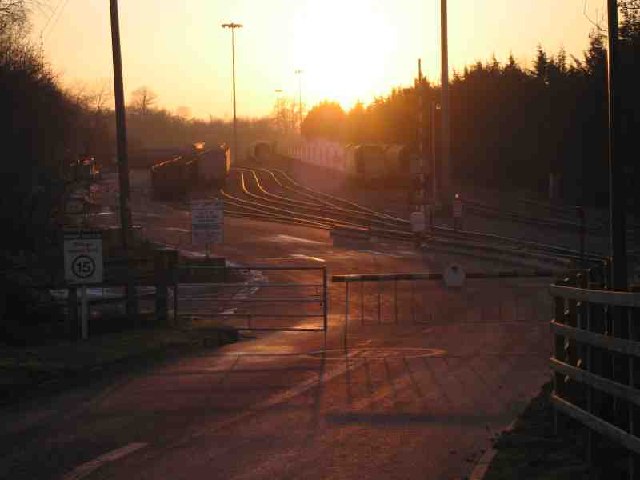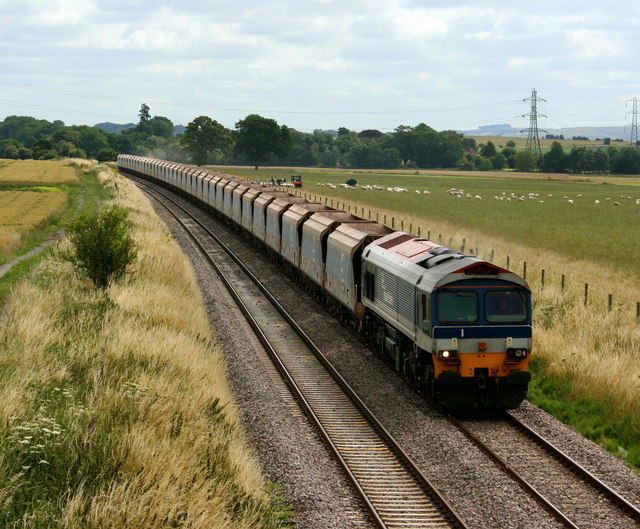|
Torr Works
Torr Works quarry, is a limestone quarry at East Cranmore, near Shepton Mallet on the Mendip Hills, Somerset, England. The quarry was formerly known as Merehead, a name which has been retained for its rail depot on the opposite side of the A361 road. Geology The site, located not far from a limestone deposit, covers an area of some 205 hectares, including 60 hectares which have been landscaped to blend with the surrounding countryside. A geodiversity audit of the site in 2004 recorded pale to dark grey well bedded Carboniferous Limestone dipping consistently southwards with a small area of overlying horizontally bedded buff-coloured Jurassic oolitic limestone forming an angular unconformity. History In 1938 the recently opened Merehead Quarry was taken over by Limmer and Trinidad. 25 men were employed at the time. In 1958 the quarry was sold to Foster Yeoman who had been working Dulcote Quarry near Wells. The quarry was renamed Torr Works (after Ron Torr, the Chief Engineer) ... [...More Info...] [...Related Items...] OR: [Wikipedia] [Google] [Baidu] |
Jurassic
The Jurassic ( ) is a Geological period, geologic period and System (stratigraphy), stratigraphic system that spanned from the end of the Triassic Period million years ago (Mya) to the beginning of the Cretaceous Period, approximately Mya. The Jurassic constitutes the middle period of the Mesozoic, Mesozoic Era and is named after the Jura Mountains, where limestone strata from the period were first identified. The start of the Jurassic was marked by the major Triassic–Jurassic extinction event, associated with the eruption of the Central Atlantic magmatic province, Central Atlantic Magmatic Province. The beginning of the Toarcian Stage started around 183 million years ago and is marked by an extinction event associated with widespread Anoxic event, oceanic anoxia, ocean acidification, and elevated temperatures likely caused by the eruption of the Karoo-Ferrar, Karoo-Ferrar large igneous provinces. The end of the Jurassic, however, has no clear boundary with the Cretaceous and i ... [...More Info...] [...Related Items...] OR: [Wikipedia] [Google] [Baidu] |
East Somerset Railway
The East Somerset Railway is a heritage railway in Somerset, running between Cranmore and Mendip Vale. Prior to the Beeching Axe, the railway was once part of the former Cheddar Valley line that ran from Witham to Yatton, meeting the Somerset and Dorset Joint Railway at Wells. History The East Somerset Railway Company was incorporated under the East Somerset Railway Act on 5 June 1856 and was built as a broad gauge line. The line was originally between Witham railway station and Shepton Mallet and this line opened on 9 November 1858. It was planned by Mr. Brunel and built by engineer Mr. Ward and contractor Mr. Brotherwood. The station buildings at Shepton and Witham Friary, as well as the bridges along the route, were constructed of Inferior Oolite from nearby Doulting Stone Quarry. Shepton was now from London by rail, a journey of just over four hours. Four years later the line was extended to Wells; this part of the line was opened on 1 March 1862. The East Somerse ... [...More Info...] [...Related Items...] OR: [Wikipedia] [Google] [Baidu] |
Mendip Rail
Mendip Rail Ltd is an independent freight operating railway company in Great Britain. It is a joint venture composed of the rail-operation divisions of Aggregate Industries (formerly Foster Yeoman) and Hanson Aggregates (previously ARC). The company operates aggregate trains from the quarries of the Mendip Hills in South-West England, to London and South-East England. The Foster Yeoman quarries are at Torr Works and Dulcote Quarry, while Hanson has plants at Batts Combe Quarry and Whatley Quarry. The company operates four Class 59/0 diesel locomotives owned by Aggregate Industries and four Class 59/1 locomotives owned by Hanson. In addition, two SW1001 Switchers are owned and operated at Whatley and Merehead quarries. It owns Merehead Traction Maintenance Depot (Merehead TMD) where the eight locomotives are allocated. They can also be seen at Hither Green TMD or Eastleigh Works where they receive heavy maintenance. Foster Yeoman Foster Yeoman purchased its own fleet of 14 ... [...More Info...] [...Related Items...] OR: [Wikipedia] [Google] [Baidu] |
Aggregate Industries
Aggregate Industries, a member of the Holcim Group, is a company based in the United Kingdom with headquarters at Bardon Hill, Coalville, Leicestershire. Aggregate Industries manufactures and supplies a range of heavy building materials, primarily aggregates such as stone, asphalt and concrete, to the construction industry and other business sectors. Aggregate Industries also manufactures and imports cement, and provides a range of aggregate-associated goods and services, these include the manufacture of masonry and reconstructed stone items for construction industry and domestic applications, the manufacture of pre-cast concrete items, the supply of ready mixed concrete, design and project management consulting, and resurfacing contracting services. Aggregate Industries operates more than 60 quarries in the UK and has several bases throughout mainland Europe and Scandinavia. Its clients operate in a range of services including construction, aviation, education, horticulture, r ... [...More Info...] [...Related Items...] OR: [Wikipedia] [Google] [Baidu] |
Wells, Somerset
Wells () is a cathedral city and civil parish in the Mendip district of Somerset, located on the southern edge of the Mendip Hills, south-east of Weston-super-Mare, south-west of Bath and south of Bristol. Although the population recorded in the 2011 census was only 10,536, (increased to 12,000 by 2018) and with a built-up area of just , Wells has had city status since medieval times, because of the presence of Wells Cathedral. Often described as England's smallest city, it is actually second smallest to the City of London in area and population, but unlike London it is not part of a larger urban agglomeration. Wells takes its name from three wells dedicated to Saint Andrew, one in the market place and two within the grounds of the Bishop's Palace and cathedral. A small Roman settlement surrounded them, which grew in importance and size under the Anglo-Saxons when King Ine of Wessex founded a minster church there in 704. The community became a trading centre based on ... [...More Info...] [...Related Items...] OR: [Wikipedia] [Google] [Baidu] |
Dulcote Quarry
Dulcote Quarry is a disused limestone quarry at Dulcote, near Wells on the Mendip Hills, Somerset, England. The quarry measures around from West to East and around from North to South, with an area of , which is surrounded by of woodland. The site has been used for quarrying since the mid-19th century. The Foster Yeoman Company was founded at Dulcote, in 1923, and later became part of Aggregate Industries. The site achieved an output of approximately 0.25M tonnes per year of Carboniferous Limestone, for general purpose construction aggregates. Much of the stone was moved on the Cheddar Valley Line (a branch line of the Great Western Railway) by an independent company which became known as Mendip Rail. A Geodiversity audit of the site was carried out in 2004, which highlighted the limestone strata and fossils identified. These include Carboniferous Limestone overlain by Triassic Mercia Mudstones and Sandstones with geodes, which were formed by siliceous mineral replacement. ... [...More Info...] [...Related Items...] OR: [Wikipedia] [Google] [Baidu] |
Foster Yeoman
Foster Yeoman Limited, based near Frome, Somerset, England, was one of Europe's largest independent quarrying and asphalt companies. It was sold to Aggregate Industries in 2006. History The company was founded by Foster Yeoman, from Hartlepool, at Dulcote, near Wells, in 1923. He was a former ship owner and had worked in the iron and steel business. Yeoman had served in the First World War and went into quarrying to provide employment for ex-soldiers. Between the wars Foster Yeoman Limited supplied contractors and local authorities in the South of England, reaching an early peak of prosperity in the 1930s. During the Second World War, the firm supplied materials for the construction of airfields. Most stone was sent away by rail as it is today. After the war, with Foster Yeoman ailing, business declined and the company came full circle, returning to the £20,000 turnover it had enjoyed in 1923. In 1949, Foster died and his son, John Foster Yeoman, became a managing director at ... [...More Info...] [...Related Items...] OR: [Wikipedia] [Google] [Baidu] |
Unconformity
An unconformity is a buried erosional or non-depositional surface separating two rock masses or strata of different ages, indicating that sediment deposition was not continuous. In general, the older layer was exposed to erosion for an interval of time before deposition of the younger layer, but the term is used to describe any break in the sedimentary geologic record. The significance of angular unconformity (see below) was shown by James Hutton, who found examples of Hutton's Unconformity at Jedburgh in 1787 and at Siccar Point in 1788. The rocks above an unconformity are younger than the rocks beneath (unless the sequence has been overturned). An unconformity represents time during which no sediments were preserved in a region or were subsequently eroded before the next deposition. The local record for that time interval is missing and geologists must use other clues to discover that part of the geologic history of that area. The interval of geologic time not represented is ... [...More Info...] [...Related Items...] OR: [Wikipedia] [Google] [Baidu] |
Oolite
Oolite or oölite (''egg stone'') is a sedimentary rock formed from ooids, spherical grains composed of concentric layers. The name derives from the Ancient Greek word for egg (ᾠόν). Strictly, oolites consist of ooids of diameter 0.25–2 millimetres; rocks composed of ooids larger than 2 mm are called pisolites. The term ''oolith'' can refer to oolite or individual ooids. Composition Ooids are most commonly composed of calcium carbonate ( calcite or aragonite), but can be composed of phosphate, clays, chert, dolomite or iron minerals, including hematite. Dolomitic and chert ooids are most likely the result of the replacement of the original texture in limestone. Oolitic hematite occurs at Red Mountain near Birmingham, Alabama, along with oolitic limestone. They are usually formed in warm, supersaturated, shallow, highly agitated marine water intertidal environments, though some are formed in inland lakes. The mechanism of formation starts with a small fragment of ... [...More Info...] [...Related Items...] OR: [Wikipedia] [Google] [Baidu] |
Carboniferous Limestone
Carboniferous Limestone is a collective term for the succession of limestones occurring widely throughout Great Britain and Ireland that were deposited during the Dinantian Epoch of the Carboniferous Period. These rocks formed between 363 and 325 million years ago. Within England and Wales, the entire limestone succession, which includes subordinate mudstones and some thin sandstones, is known as the Carboniferous Limestone Supergroup. Depositional basins Within Great Britain the suite of rocks known traditionally as the Carboniferous Limestone Series was deposited as marine sediments in three distinct ‘provinces’ separated by contemporary landmasses. One of these landmasses was the Wales-London-Brabant Massif, an east–west aligned belt of land stretching through central Wales and the English Midlands to East Anglia and on into Belgium. The limestones deposited to its south form a distinct South Wales-Mendip province which extends from Pembrokeshire in the west through ... [...More Info...] [...Related Items...] OR: [Wikipedia] [Google] [Baidu] |








